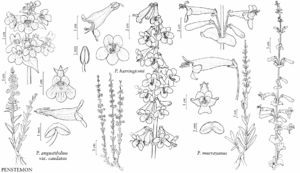Penstemon harringtonii
Madroño 14: 153, fig. 1. 1958.
Stems erect, (30–) 40–70 cm, glabrous. Leaves basal and cauline, glabrous; basal and proximal cauline (15–) 30–70 × (6–) 13–26 mm, blade trullate to ovate or elliptic, base tapered, apex acute, obtuse, rounded, or mucronate; cauline 3–7 pairs, sessile, (10–) 18–53 × (7–) 12–26 mm, blade ovate to elliptic or oblanceolate, base tapered to clasping, apex obtuse to acute, rounded, or mucronate. Thyrses interrupted, cylindric, 13–30 cm, axis glabrous, verticillasters 6–10, cymes 1–4 (–7) -flowered; proximal bracts ovate to lanceolate, 10–20 × 3–12 mm; peduncles and pedicels glabrous. Flowers: calyx lobes ovate to lanceolate, 3.5–7 (–9) × 2–2.7 mm, margins entire or erose, broadly scarious, glabrous; corolla blue to violet, lavender, or pinkish blue, without nectar guides, funnelform, 17–24 mm, glabrous externally, glabrous internally, tube 8–11 mm, throat gradually inflated, 5–7 mm diam., rounded abaxially; stamens: 2 prominently exserted, 4–6 mm, 2 included, pollen-sacs parallel or divergent, 2–3 mm, sutures smooth; staminode 7–10 mm, included or reaching orifice, 0.5–1 (–1.5) mm diam., tip recurved, distal 4–6 mm densely villous, hairs golden yellow, to 1.5 mm; style 18–22 mm. Capsules 7–11 × 4–6 mm.
Phenology: Flowering Jun–Jul.
Habitat: Sandy soils, sagebrush shrublands, pinyon-juniper woodlands.
Elevation: 2000–2900 m.
Distribution
Colo.
Discussion
Penstemon harringtonii is known from Eagle, Garfield, Grand, Pitkin, Routt, and Summit counties in northwestern Colorado (S. S. Panjabi and D. G. Anderson 2006). It sometimes grows with P. osterhoutii.
Selected References
Lower Taxa
"/4+timescorollathroat" is not declared as a valid unit of measurement for this property.
